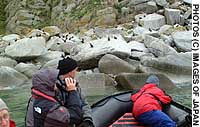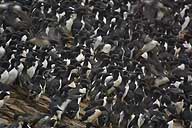Birds' island havens failing whole species
By Mark Brazil | Oct 31, 2002
ALL AT SEATeuri-jima Island is a special place, being a legally protected breeding habitat of seabirds. It was also the main subject of a recent Japan-U.S. government-level symposium in the nearby mainland town of Haboro, Hokkaido. Shocking facts emerged from that meeting.
Over recent decades, local residents have taken the common murre (ororoncho) to their hearts. Images of it have made their way onto posters, stained glass — and even steel drain covers. In every way, the common murre has become the town’s symbol. Yet the birds themselves have quietly slipped away.
Seventy years ago, 40,000 murres crowded the nesting cliffs of Teuri-jima. In the 1960s, that throng had dwindled to about 8,000, and by the 1980s to the low hundreds. This year, there were just 13.
That any bird in Japan should have suffered such a fate is saddening, but when it is the symbol bird of a “seabird” town, it is shocking. And this bleak picture gets even worse. Though the rapid decimation of one seabird species should ring warning bells — when a whole suite of species follows, there should be an adrenaline rush of panic.
This is the case in Hokkaido, where, over the last 10 years, the fate of the common murre has been shared at other locations by the tufted puffin (etopirika) — symbol bird of Hamanaka and Nemuro — of which there are now fewer than 15 pairs; the spectacled guillemot (keimafuri), which once occurred by the thousand throughout the Tohoku region and Hokkaido, but which is now down to fewer than 100 pairs and declining by 8 to 15 percent a year; the ancient murrelet, of which there are now fewer than 20 pairs; and the red-faced cormorant.
Together, the fates of these seabirds points to a catastrophe in the making — and a glaring gap in legislation.
This gap exists because though these seabirds are legally protected, there are no exclusion zones to protect their feeding areas. Hence, ironically, anyone wishing to study them at close quarters will be daunted by the paperwork required, yet any fishers killing them accidentally in a net are immune to punishment.
Under almost equally bizarre circumstances, another seabird, the black-tailed gull (umineko), lives a double life.
On Teuri, where its population declined from 20,000 pairs in the 1980s to half that number by the late 1990s, it is the focus of concern. There, conservationists are looking for ways to prevent any further decline in its numbers — a decline accelerated by the appetites of the island’s 300-odd feral cats.
Meanwhile, to the north, on Rishiri, just west of Wakkanai, the same seabird is under attack . . . from islanders who have eradicated nests and eggs, forced a colony to move through disturbance, and have tried various other means to reduce the population. It seems that in their campaign to cull the gulls, they haven’t ever considered the possibility of them being a major tourist attraction for the future.
Nevertheless, that leaves the black-tailed gulls in a precarious position. If the Rishiri birds were to move to Teuri, they would receive moral support from local conservationists — but would likely have their eggs and chicks eaten by cats. Conversely, if the Teuri gulls were to escape the cats by moving to Rishiri, they would likely be persecuted there by people.
In another odd twist of wildlife law, while no one can be prosecuted under the Conservation of Endangered Species of Wild Fauna and Flora legislation for killing native seabirds in fishing nets, any attempt to control the feral cats invites prosecution. Why? Because the introduced alien species is protected by anti-cruelty laws, so you can’t just go around eradicating them without special permission.
What this symposium starkly highlighted was the enormous contrast between Japan’s laws and those in both the United States and Russia. For instance, if Alaskan fishers accidentally kill a handful of Japanese short-tailed albatrosses as the seabirds pass through American waters, their fishing industry could face being closed down — a considerable incentive to avoiding bycatch. To the north in Russia, Japanese fishers are fined for each seabird they kill. Meanwhile in Japan, fishers suffer no consequences whatever, regardless of how many seabirds they kill. It seems that the Endangered Species Act in the U.S., and the equivalent laws in Russia, provide better protection for Japanese seabirds than Japan’s own laws do!
But the symposium was not merely waving a red flag signalling imminent extinction for several of Japan’s seabirds. It was addressing bigger issues, too — not least the state and fate of our oceans and those who depend on them, both humans and non-humans.
For more than 20 years, Hokkaido’s coastal fishing communities have been shifting from species to species as each declines to the point where it’s not just the livelihood of future generations that is compromised, but that of the current generation, too. The seas appear to represent such a boundless resource, a source of endless seafood . . . and a bottomless pit for waste dumping. Fishing communities, however, are realizing the limits, though they’re not yet acting on that realization.
Among the symposium’s many distinguished speakers from the U.S. and Japan, it was Haruo Ogi, a professor at Hokkaido University, who stunned me the most. His work on plastic waste has shown that much of the 50 million tons of the stuff generated annually worldwide reaches the oceans. Some floats, some submerges to different depths, some sinks to the bottom, so that it is affecting every layer of the ocean. The density of plastic and resin fragments is so great in some areas, Ogi has found, that it reaches 2 million pieces per sq. km. The particles may be tiny, but nevertheless they affect light penetration and hence primary production of the seas — and, of course, birds and fish mistakenly ingest them for food.
The symposium was a reminder of the enormity of the issues we face in relying on the oceans. But alas, it fell short of proposing concrete responses to the pressing problems of pollution, bycatch and overfishing.


